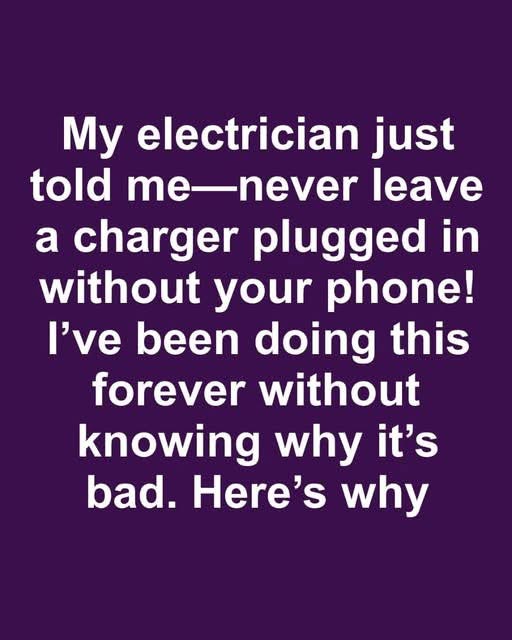
In today’s fast-paced digital world, the convenience of keeping phone chargers plugged in at all times is a habit many people rarely question. However, electricians and safety experts warn that this seemingly harmless practice carries risks that extend beyond just wasted energy. Understanding these dangers can help prevent potential hazards, extend the lifespan of electronic devices, and promote more efficient energy use.
The Hidden Dangers of Always-Plugged Chargers
Phone and tablet chargers work by converting the alternating current (AC) from wall outlets into direct current (DC) to power devices. However, even when no device is connected, the charger continues to draw small amounts of electricity, a phenomenon known as “vampire energy” or “standby power.”
While a single charger’s energy use may seem insignificant, the cumulative effect of millions of chargers left plugged in worldwide results in considerable energy waste, increased utility costs, and unnecessary strain on power grids.
More concerning than wasted energy, however, is the risk of fire. Chargers—especially those that are low-quality, counterfeit, or damaged—can overheat when left plugged in for long periods. Over time, overheating can degrade internal components, increasing the likelihood of electrical shorts and fires. The risk is even greater when chargers are plugged into overloaded power strips, placed near flammable materials, or exposed to high temperatures.
Environmental and Financial Consequences
Beyond fire hazards, the continuous use of chargers contributes to environmental issues. The energy consumed by idle chargers may be small on an individual level, but on a global scale, the waste adds up significantly. This unnecessary consumption increases carbon emissions and places additional strain on natural resources used to generate electricity.
By simply unplugging chargers when they’re not in use, households can contribute to energy conservation and environmental sustainability.
Financially, while the cost of leaving a single charger plugged in may not seem alarming, the accumulated impact over time can be noticeable. Households with multiple devices—smartphones, tablets, laptops, and other rechargeable electronics—end up paying for energy they aren’t even using. Additionally, prolonged exposure to electrical currents can degrade both chargers and wall outlets, leading to more frequent replacements and increased long-term expenses.
Impact on Charger and Outlet Longevity
Another often-overlooked consequence of leaving chargers plugged in is the wear and tear it causes on both the charger itself and the electrical outlet. Continuous minor electrical flow, along with potential power surges, can weaken internal components, reducing the lifespan of chargers. In some cases, this can lead to premature failure, requiring costly replacements more often than necessary.
Similarly, outlets that frequently house plugged-in chargers may loosen over time, resulting in poor connections and an increased risk of electrical arcing. This can further contribute to overheating, fire hazards, or even potential electrocution if the outlet becomes damaged.
Best Practices for Charger Safety and Energy Efficiency
To mitigate these risks and improve energy efficiency, electricians and safety experts strongly recommend the following:
Unplug chargers when not in use – This simple habit reduces standby power consumption and minimizes fire risks.
Use high-quality, certified chargers – Counterfeit or substandard chargers are more prone to overheating and electrical malfunctions.
Always opt for reputable brands that meet safety standards.
Inspect chargers regularly – Check for frayed cords, discoloration, or unusual heat buildup. Damaged chargers should be replaced immediately.
Utilize power strips with on/off switches – This allows for easy disconnection of multiple devices at once, reducing energy waste.
Consider smart plugs – These devices automatically cut off power when a device is fully charged, preventing unnecessary energy use.
A Small Change with Big Benefits
Adopting the habit of unplugging chargers when they are not in use requires minimal effort but offers significant benefits. It reduces fire hazards, extends the life of electronic devices, lowers electricity costs, and contributes to environmental conservation. In a world increasingly focused on sustainability and energy efficiency, small adjustments like this can collectively make a major impact.
While convenience often leads people to leave chargers plugged in indefinitely, the risks far outweigh the small effort it takes to unplug them. Making this minor change in daily routines is a practical and effective way to enhance safety, save money, and reduce environmental harm—one unplugged charger at a time.